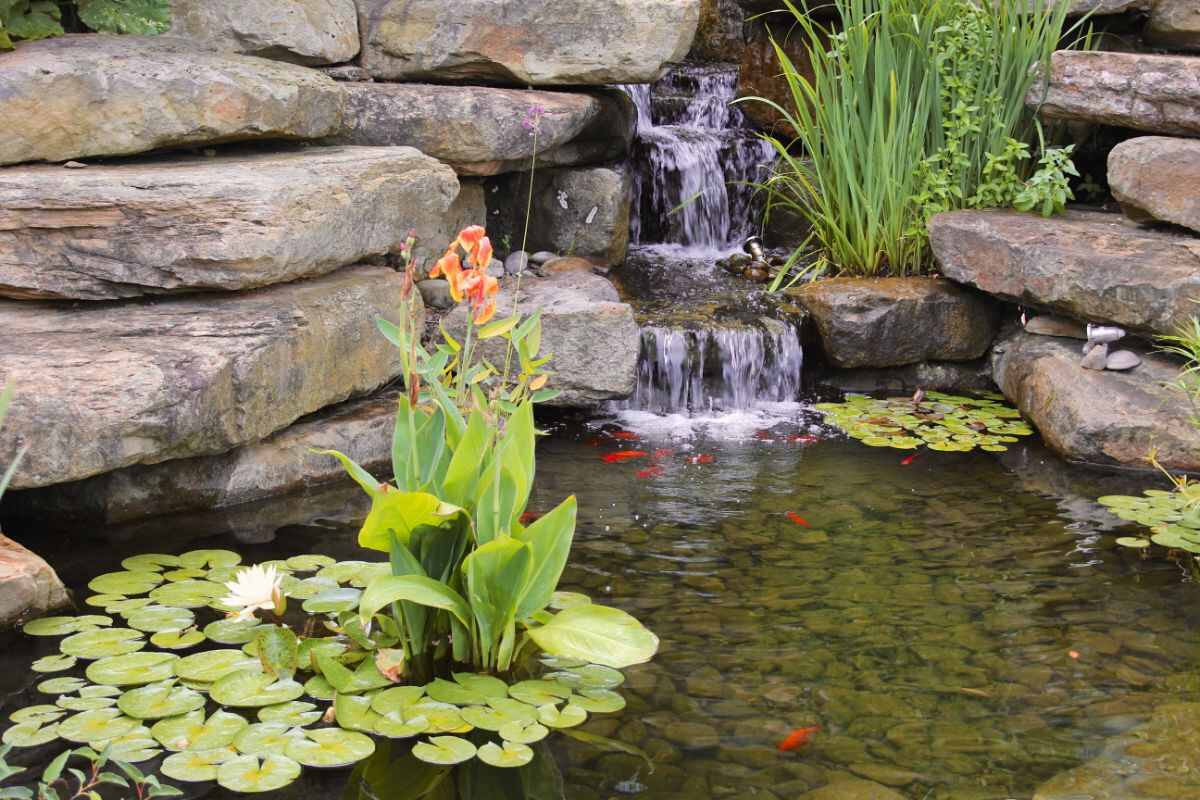
Choosing the best plants for your koi pond is a beautiful but challenging task, especially when working with a small water feature. Submerged plants are ideal for oxygen. Water lilies, poppies, and other floaters give shade and limit algae growth. Marginals are great filters, and all of them look amazing.
So, what do you choose? Use this article to guide you. We talk about 16 of the best koi pond plants and what they have to offer. You’ll also read about what to expect in terms of maintenance and where these plants grow best.
Note: New to the beautiful world of koi ponds? Take a look at our guide on what a koi pond is and how it works.
Best 16 Koi Pond Plants
1. Water Lotus (Nelumbo lutea)
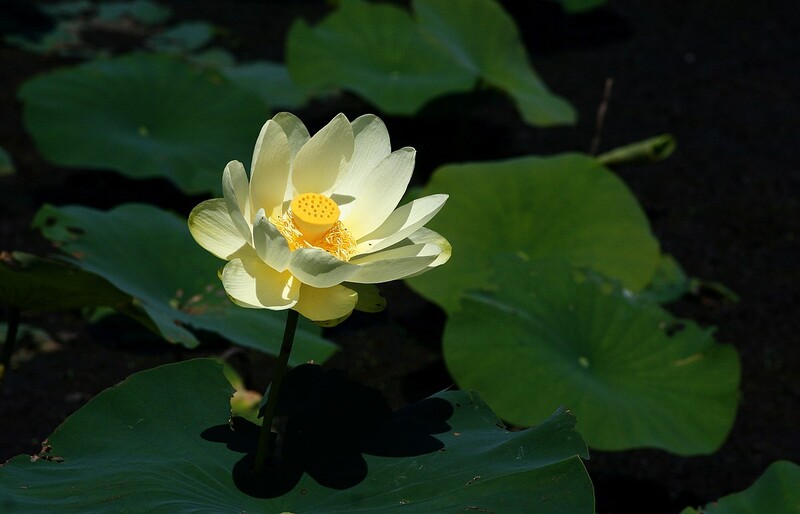
Exotic and delicate, the water lotus will compete with your koi for the most beautiful thing in the pond. It has stunning, fragrant, bowl-like flowers ranging from white to yellow and pink. Some are as large as a medium-sized pizza. When it rains, water magically dances on its round, waxy leaves in mercury-like drops.
The water lotus is also picky like a primadonna about space and climate, requiring 75 to 86°F and full sun to thrive. Standard varieties have pads up to 2 feet across, suitable for large ponds. For a mid-size pond, choose a dwarf variety, also called micro lotus or bowl-lotus, such as dense dew lotus, cui yun lotus, or diamond dust lotus.
- Light: They enjoy sunny locations.
- Type: Floating plant
- Koi food: No, koi don’t seem to like them as food.
- Invasive: Not invasive, but very large, taking up a lot of space.
- USDA hardiness zones: Thrives in zones 4 to 11
- How to plant: Pots or planting bags
2. Water Lilies (Nymphaea)
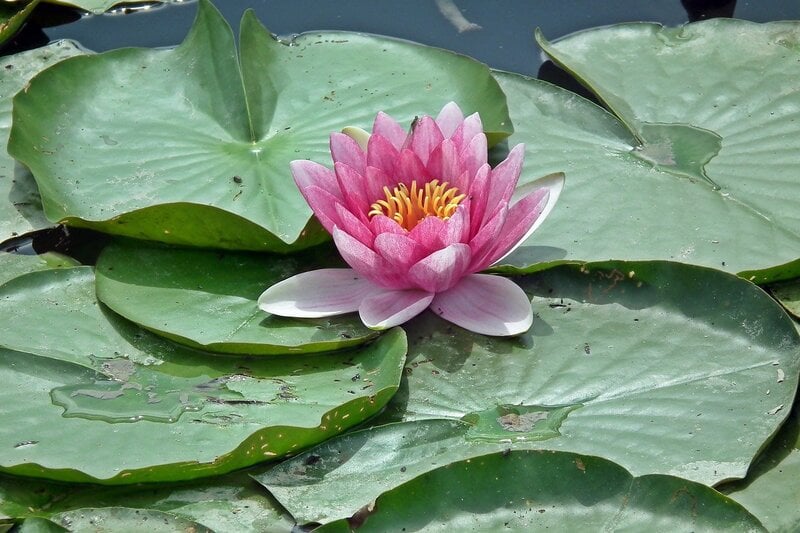
Gorgeous and irresistible, water lilies come to the rescue when the exotic lotus is too big for your pond. Their heart-shaped pads grow only up to 18 inches across. Water lily flowers are round to radiale, in splendid tints of red, pink, orange, yellow, and white.
Hardy varieties survive winter freeze. Tropical cultivars need special care, but they will reward you with their enticing fragrance, and some bloom at night.
Besides looking amazing, water lilies also provide shade to your koi and limit algae growth. Koi eat the roots and use the underside of the leaves to lay eggs.
- Light: Full sun to partial shade
- Type: A floating plant with roots and stems below the water
- Koi Food: Koi fish eat their roots.
- Invasive: No
- USDA hardiness zone: Hardy water lilies are hardy in zones 3 to 11 and thrive in the Northern United States.
- How to plant: Pots or planting bags
3. Hornwort (Ceratophyllum demersum)
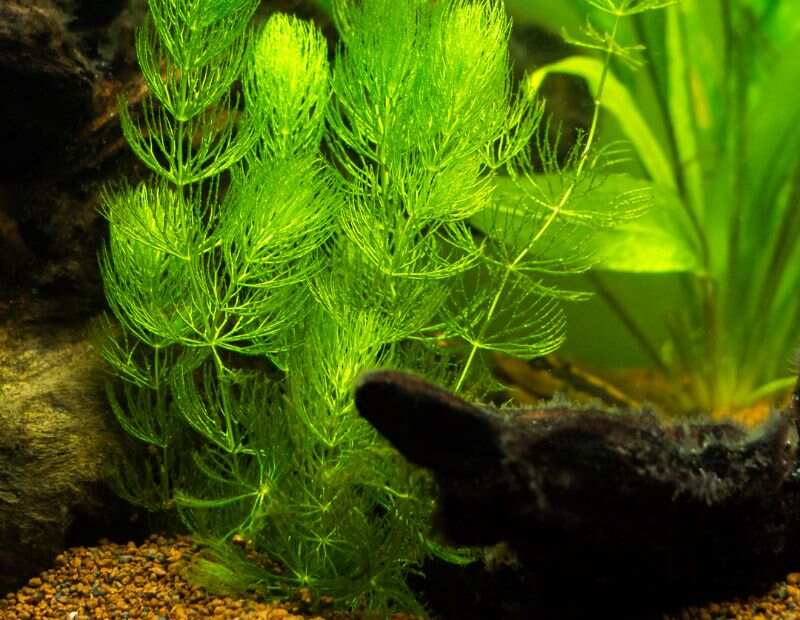
Also called coon tails, hornwort is a bushy aquatic plant that thrives at the bottom of your pond. Its leaves are bright green, rigid, and thin, similar to pine leaves. Not having proper roots, hornwort often forms fluffy floating mats.
Hornwort is a delicious snack for your koi fish but also grows fast enough to deal with their appetite. It consumes excess nutrients, limits algae growth, oxygenates the water, and keeps it clean. A big plus is the valuable underwater habitat it creates for your koi during winter.
- Light: Full sun to soft light
- Type: Submerged, floating near the water surface
- Koi Food: Yes, it’s a tasty snack for koi.
- Invasive: Can become invasive if not trimmed from time to time.
- USDA hardiness zone: Hardy in zones 5 to 11 and overwinters well, even in cold climates
- How to plant: Just place it in the pond water.
4. Horsetail (Equisetum)
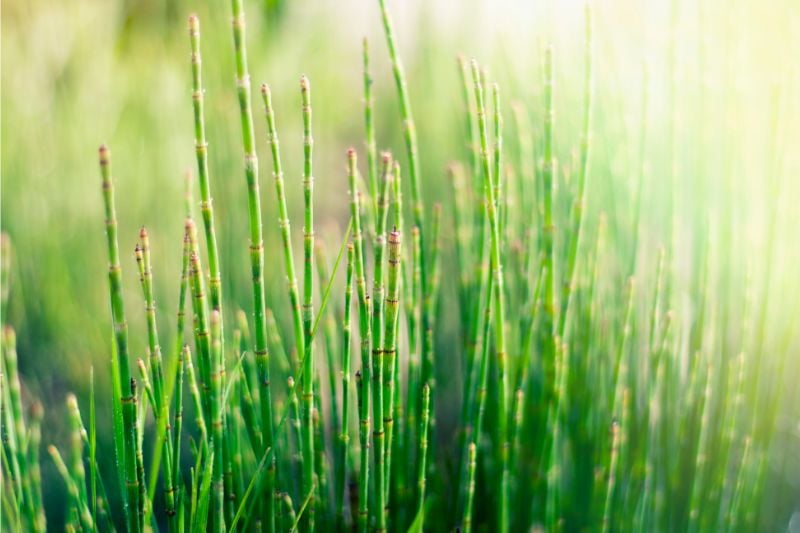
Horsetail has hollow, straight stems similar to thin bamboo, with a black band around each of its joints. Most cultivars grow in wet soils and just a few in water. Also called scouring rush, horsetail is extremely cold tolerant. Many cultivars keep their green during winter. Horsetail filtrates the water, capturing excess nutrients and contaminants. Koi fish love to hide in its shadow.
- Light: Partial shade
- Type: Marginal plant that grows in wet soils.
- Koi food: No
- Invasive: Some varieties can become invasive if planted directly into the soil and not trimmed in time.
- USDA hardiness zone: Thrive in zones 4 to 11
- How to plant: In a pot or planting bag
5. Water Iris (Iris pseudacorus)
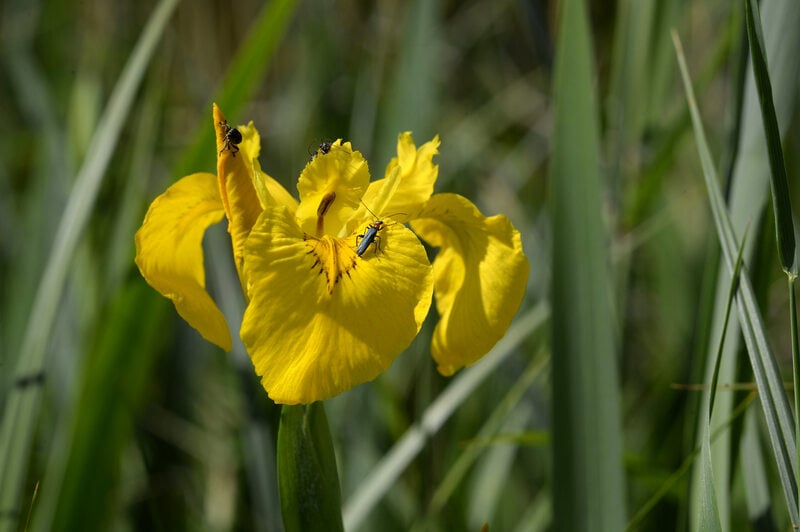
Resilient and beautiful, water-side irises thrive in shallow water. You’ll see them bloom from May to July in every color of the rainbow if you mix the right varieties. Elegant and tall, a water iris will always be a central landscape plant. Make them shine near delicate plants such as the parrot feather or marsh marigold.
- Light: Enjoys full sun to partial shade
- Type: Marginal plant, grows better in shallow water, up to 5 inches, just deep enough to cover the crown
- Koi Food: No
- Invasive: Fast-spreading; can become invasive
- USDA hardiness zone: Hardy in zones 4 to 9
- How to plant: Submerged pots
6. Water Poppy (Hydrodeys nymphoides)
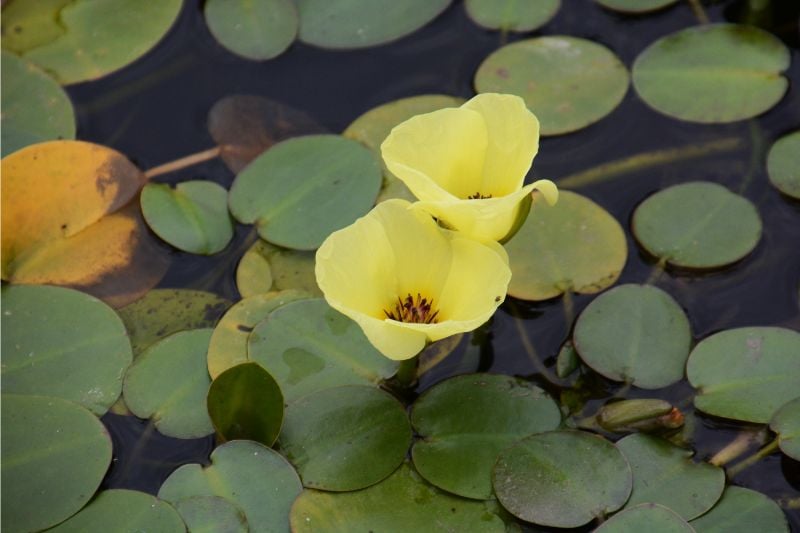
Easy to grow and resilient, water poppies are a great addition to cold-climate koi ponds. As a bonus, the low temperatures keep their running habit under control. This plant covers the pond in lovely rounded leaves and creamy yellow flowers. It blooms once the water reaches 70 to 75°F.
- Light: Likes full sun but tolerates a lot of shade
- Type: Floating, water lily-like plant
- Koi food: Yes
- Invasive: Fast-growing; can become invasive if not pruned on time
- USDA hardiness zone: It grows well in zones 9 to 11.
- How to plant: In wide, shallow pots submerged about 6 inches deep
7. Watercress (Tropaeolum majus)
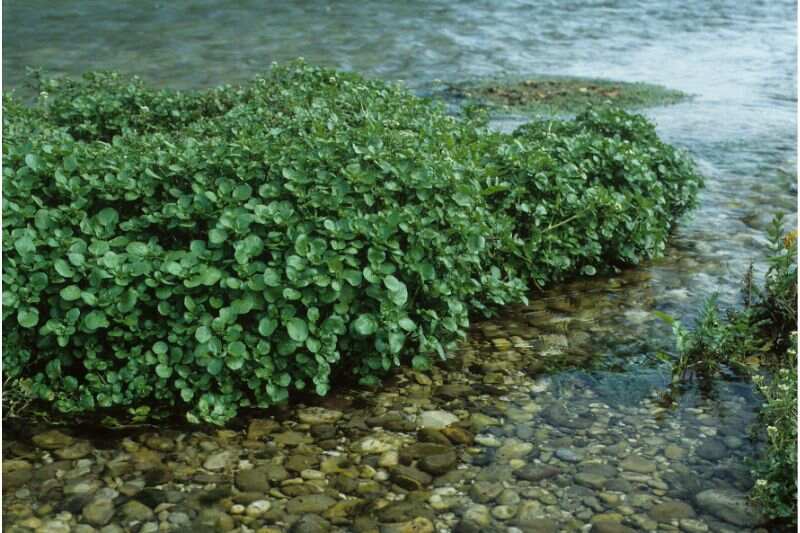
Easy to plant and grow, watercress is also great at removing pollutants from the water. Its flowers are white, spread among toothy, mustard-like evergreen leaves. Watercress has a trailing habit, so you’ll often see its stems floating in the water.
- Light: Thrives in full sun and partial shade
- Type: Marginal plant
- Koi Food: Yes, watercress is eaten by koi.
- Invasive: Can become invasive if not kept under control
- USDA hardiness zone: It is hardy in zones 4 to 9.
- How to plant: In mesh pots
8. Water Purslane (Ludwigia palustris)
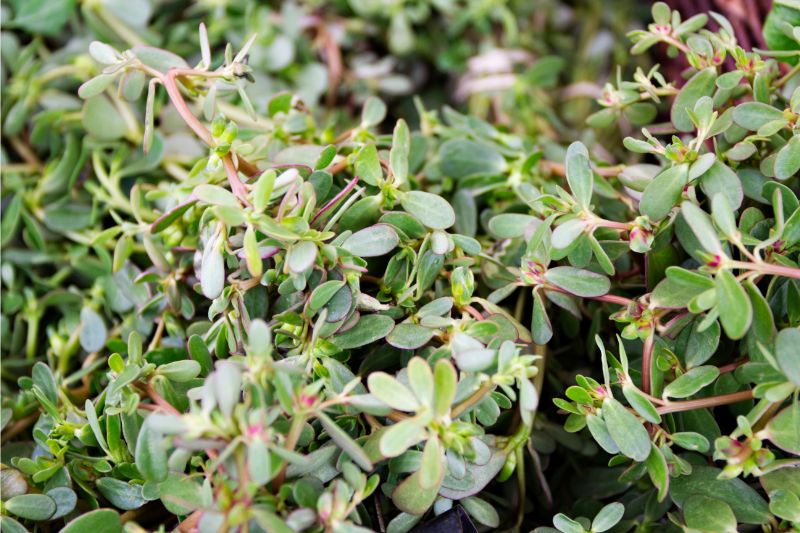
Water purslane is a popular mat-forming plant used along koi ponds and in water or bog gardens. It provides shade and shelter, keeps the water cool in the summer, and is also an enjoyable snack for koi fish.
Marsh purslane leaves have a unique purple or crimson tint and grow on succulent stems. It creates a lush green cover around rocks and stones in various koi pond designs.
- Light: Needs plenty of sunlight
- Type: Marginal plant that grows well in muddy ground and shallow waters
- Koi Food: Yes, koi fish eat it, and over-snacking is fine, since it grows quickly.
- Invasive: Fast-growing; needs trimming from time to time
- USDA hardiness zone: It thrives in zones 3 to 7.
- How to plant: Add to the gravel/soil around the pond.
9. Water Smartweed (Persicaria amphibia)
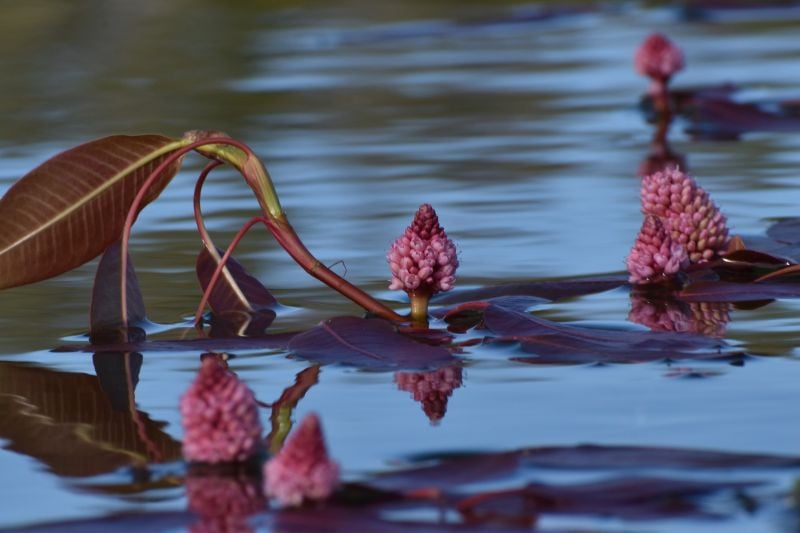
You can plant water smartweed submerged to oxygenate the water and filter toxins or along the edge of the pond for privacy and some shade. It grows in colonies up to 3 feet tall, with leathery green leaves and thick spikes of rosy-pink flowers. Smartweed blooms from early summer to mid-fall. While it is not an attractive snack for koi, it attracts insects that fish enjoy eating.
- Light: Prefers full or partial sun locations
- Type: Submerged or marginal, in the boggy soil near the pond
- Koi Food: No, koi don’t eat smartweed, but it can attract insects that they will eat.
- Invasive: Proliferates and requires periodic cuttings
- USDA hardiness zones: Smartweed is native throughout the US, thriving in zones 4 to 8.
- How to plant: In a planting bag or wet soil around the pond
10. Cattails (Typha latifolia)
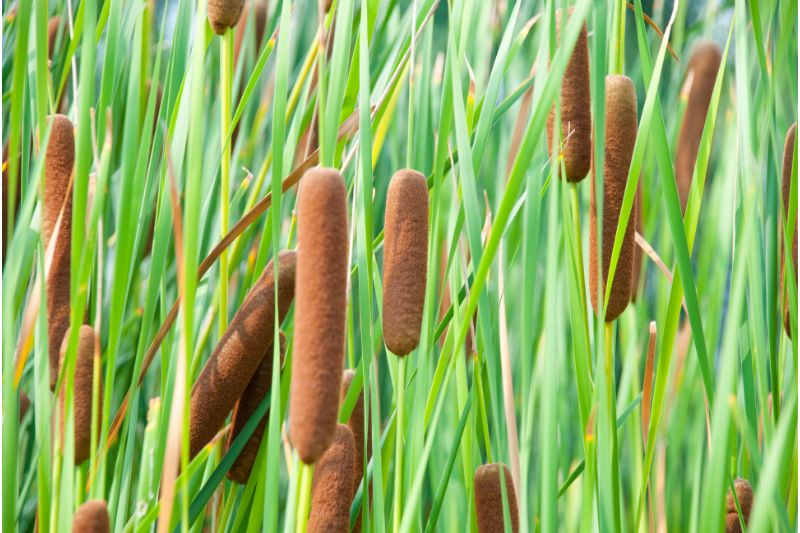
Plant cattails as an accent plant in small patches dispersed around the pond or spread them along the edge as a privacy screen and for shade. They grow 3 to 6 feet tall with long, flat leaves, blooming a brown, cylindrical flower spike that looks like a Cuban cigar.
Cattails are an excellent filter for toxic pollutants in the water. Their dense roots also harbor microorganisms that break down excess nutrients and fish debris.
- Light: Thrives in full sun and partial shade
- Type: Emergent
- Koi Food: Yes, koi love to snack on its roots.
- Invasive: Yes. You must cut or hand-pull the plants periodically to keep them under control.
- USDA hardiness zone: Thrives in zones 3 to 10
- How to plant: Plant in containers to control its spread.
11. Sweet Flag (Acorus calamus)
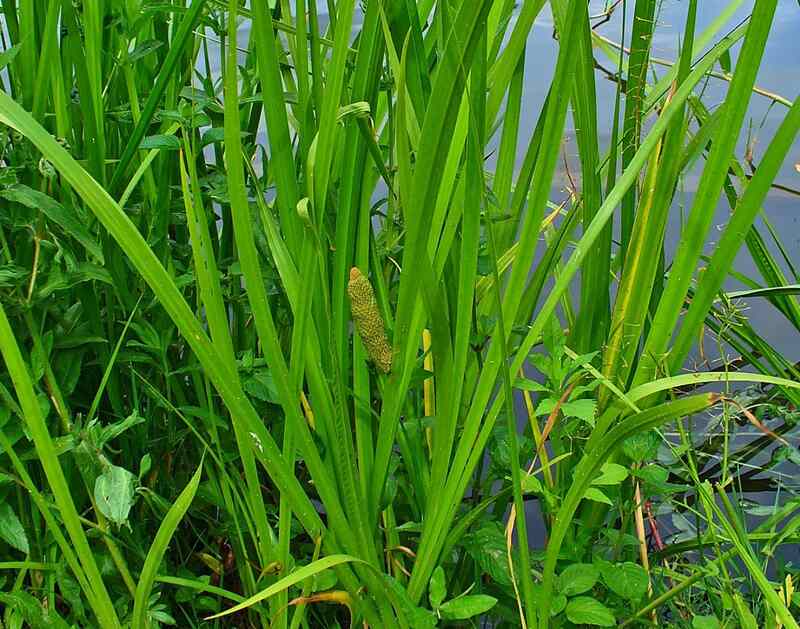
Sweet flag is a less invasive, equally beautiful alternative to cattails. We’re talking about a pond-side plant that grows citrusy-scented narrow leaves. They are 4 to 8 feet tall and up to 1 inch wide, great for shade and shelter. Looking like a cylindrical greenish-yellow finger-like spike, the sweet flag flower is not a classic. But it looks incredible around ponds and in flower bouquets.
- Light: Thrives in full sun to light shade
- Type: Marginal plant
- Koi Food: Koi don’t eat sweet flag.
- Invasive: No
- USDA hardiness zones: It grows well in hardiness zones 6 to 9.
- How to plant: Use a planting basket and place it on a shelf in your koi pond.
12. Taro (Colocasia esculenta)
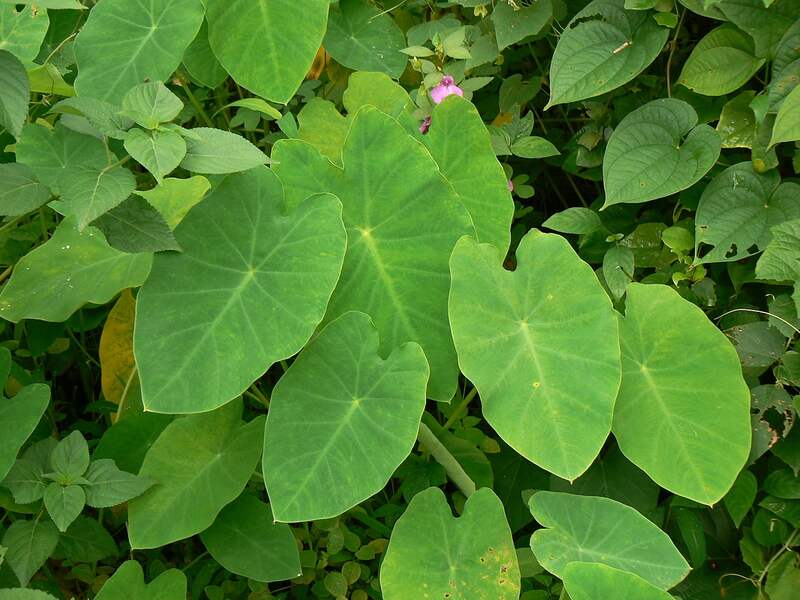
It’s not called elephant ears for nothing. Growing up to 6 feet tall, Taro has smooth, huge heart-shaped leaves that make it a “size-matters” accent plant. Place it on the edge of the pond. It provides precious shade and shelter and adds a warm, tropical feel.
- Light: Grows better in partial sun
- Type: Bog plant, grows in shallow water with its roots buried 4 to 8 inches into the ground
- Koi Food: Potentially toxic for koi. Plant it on the pond’s edge, where they don’t have access.
- Invasive: No
- USDA hardiness zones: It thrives in zones 8 to 12.
- How to plant: Place under 1 to 6 inches of water in a planting container.
13. Duckweed (Lemna minor)
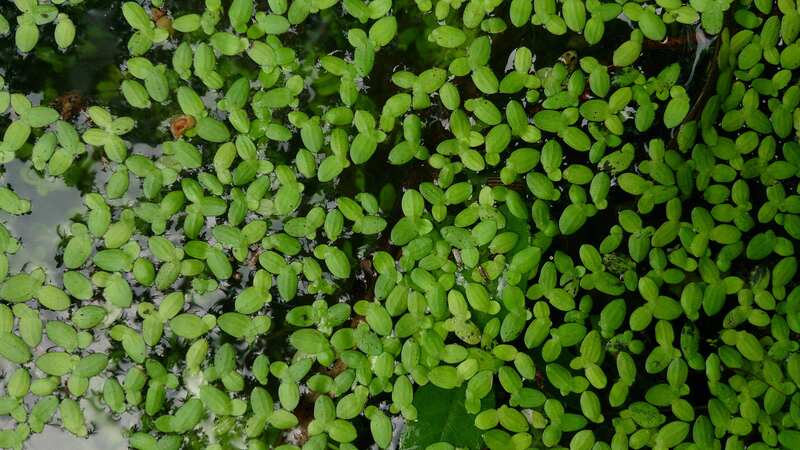
Beloved food for koi fish, duckweed is also enjoyed by tilapia, goldfish, carp, and turtles. With oval, light green leaves, this tiny plant measures 1/16 to ⅛ inch, and it’s kept afloat by small air sacs. It’s a protein-packed animal feed attracting spiders, flies, bees, mites, birds, beavers, and tadpoles.
- Light: Thrives in full sun
- Type: Floating plant
- Koi Food: Yes, koi enjoy eating it.
- Invasive: Fast-growing, potentially invasive. Shade from taller plants and water currents from aeration devices slow its growth.
- USDA hardiness zones: Thrives in zones 4 to 10
- How to plant: Just place it in the pond water.
14. Water Lettuce (Pistia stratiotes)
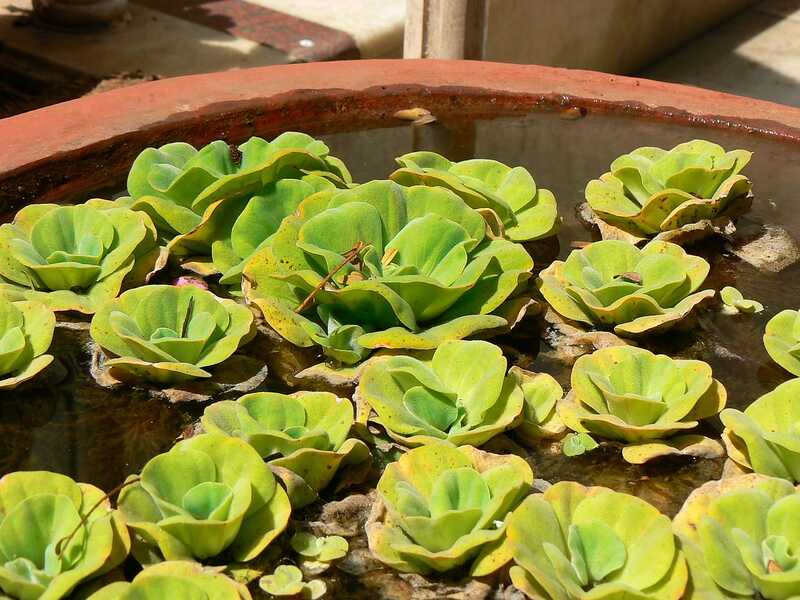
Water lettuce is a resilient, easy-to-grow floating plant that grows everywhere except Antarctica. It has beautiful rosettes of leaves that look like thick, green rose petals. The roots grow up to 20 inches deep and are great at removing excess water nutrients.
This plant grows fast, forming dense, floating mats, especially in warm climates. Besides what koi will eat, you’ll also need to thin it from time to time to keep it under control.
- Light: Thrives in full sun to partial shade
- Type: Floating plant
- Koi food: Yes, koi enjoy water lettuce.
- Invasive: Because it can become quite invasive, it’s prohibited in some states.
- USDA hardiness zone: Recommended for zones 9 to 11
- How to plant: Place them in the water and let them float.
15. Water Hyacinth (Eichornia crassipes)

The exotic water hyacinth is native to the Amazon River in Brazil. It blooms large spikes filled with butterfly-like flowers ranging from lilac to lavender. While this buoyant plant floats like a swan, its roots absorb pollutants, pesticides, and heavy metals.
There is a catch, though. Water hyacinth is highly invasive in warm climates, where it survives the winter. So much so that it’s on the Federal List of Noxious Weeds. It’s easier to manage in cold climates, where thinning and winter keep it in line.
- Light: Full sun, but also partial shade
- Type: Floating pond plant
- Koi food: Koi like to nibble at water hyacinths.
- Invasive: Highly invasive – a colony can double its size in 8 days. Prohibited in some states.
- USDA hardiness zone: It’s hardy in zones 9 to 11.
- How to plant: In planting containers
16. American Waterweed (Elodea canadensis)
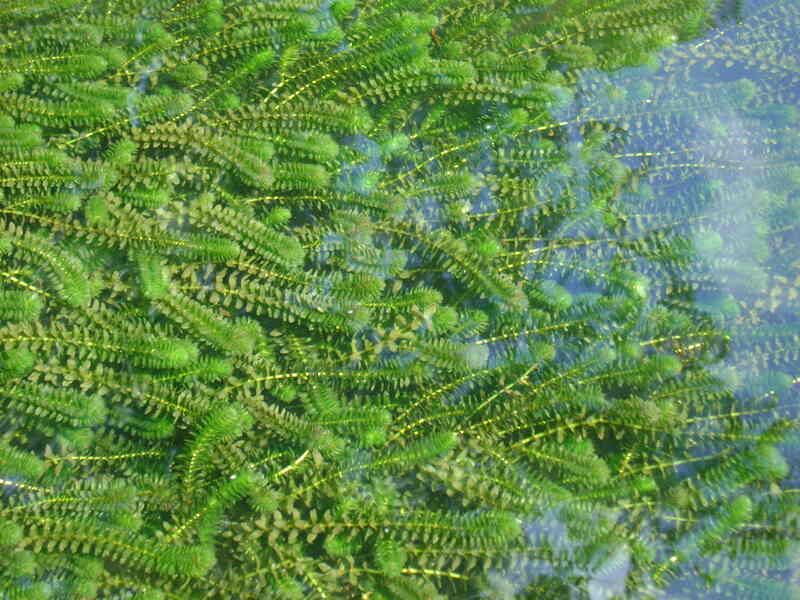
When the whole pond freezes, American waterweed stays green. It grows underwater in dense whorls of long, thin, dark-green leaves, so your koi fish will have a welcoming habitat during the cold season. Elodea is also an oxygenating plant and removes excess nutrients from the water. It can be valuable for your pond if you thin it periodically since it’s also a fast-growing, invasive plant.
- Light: Thrives in full sun
- Type: Submerged plant
- Koi Food: Yes, koi like to eat elodea plants.
- Invasive: Yes. It is a fast-growing plant prohibited in some states.
- USDA hardiness zone: Thrives in zones 4 to 10
- How to plant: In planting baskets (easier to control) or by adding some weights to the plants and placing them on the bottom gravel layer
Plants Toxic For Koi
Some plants contain substances toxic to fish, like the aesculin in the California buckeye or the grayanotoxin found in rhododendron pollen. When landscaping your pond area, add only safe species in the water, along the edge, and around the pond.
Even if they are not in the water feature, avoid trees such as:
- Red maple
- Oak
- Yew
- Oleander
- Cherry
- Peach
- Black walnut
Shrubs like rhododendron, azalea, jasmine, alocasia, and wisteria are also risky. Peonies, tiger lilies, birds of paradise, and other beautiful flowers can also put fish at risk. Contact a local koi expert if you need clarification on a variety you’d like to add.
Why Do You Need Plants in Your Koi Pond?
Besides adding color, layers, and striking textures, wetland plants play an essential role in keeping your water clean and your fish healthy. They create a complex ecosystem that balances nutrients, oxygen, and residue, assuming valuable functions, including:
- Filtration: Most aquatic plants are excellent at cleaning the water of toxic pollutants. They also deal with fish debris and excess nutrients, filtering out nitrates and phosphates. Some, like the water hyacinth, even absorb heavy metals.
- Oxygenation: Submerged plants are the best for adding fresh oxygen to your pond. Also called oxygenating plants, species like hornwort and water smartweed help your aeration system keep the water rich in oxygen.
- Algae Control: By adding shade and using part of the nutrients, all pond plants keep algae growth under control. But the elites of this group are the floating plants (water lilies, lotuses, poppies). They spread their pads over the pond, limiting algae bloom and keeping the water clear.
- Food for Koi: While you’ll still need to feed your koi, edible plants can easily be added to the menu, helping you to save money and time. Just remember to clean the vegetable debris periodically to avoid excess nutrients and clogging the skimmer.
- Habitat for Wildlife: Aquatic plants create natural habitats for insects and birds on their way to winter shelter. Some of them, such as duckweed, are as nutritious as protein bars, attracting many insects, birds, and even beavers.
- Moderate Water Temperature: Pond plants help keep the water cool during summer, improving fish comfort. Floating species are obviously the best cover, but marginals can also help. Tall, reed-like plants form dense screens along the edge, where fish love to find shelter. Large-leaved options, like elephant ear, spread shade as effectively as sun umbrellas.
A word of caution: Please bear in mind that plants can also harm your garden pond if you:
- Add poisonous plants by mistake (see a few examples in this section)
- Plant fast-growing species and don’t keep them under control
- Keep plants fish like to eat and don’t clean the residue periodically
So many places to hide also mean that sick fish might go unnoticed, so make it a habit to check on each of them from time to time.
Your pond still needs a filtration system! However magnificent the mix of aquatic plants, a koi pond still needs a proper aeration and filtration system. Plants come only as a healthy, natural supplementation. First, make sure your koi pond functions impeccably without plants, then start to add some.
FAQ
You can keep plants in your koi pond if you choose beneficial and safe options for your fish. It’s also essential to keep the more aggressive plants under control. If you go for plants that koi like to eat, you might need to top up the colonies from time to time.
Include submerged plants such as hornwort and eelgrass for water rich in oxygen. Add emergent plants like horsetail, sweet flag, and hyacinth for shelter and shade. Use water lilies, poppies, and other floaters to keep algae under control and the water cool in the summer.
Koi eat water lilies, hornwort, mosaic plants, hyacinths, duckweed, and water lettuce. Since most of these water plants are fast-growing, a little nibbling is rarely a problem.
Experts advise covering no more than 50% of the pond with plants to provide shelter for the fish and reduce excess nutrients. This also limits algae growth and moderates water temperature on hot days.
Installing a mid-sized koi pond in your backyard costs $5,100 to $15,900. The cost depends on size, design, number and type of koi fish, and your chosen plants. Also, set aside about $1,000 to $2,000 per year for koi pond maintenance costs.
If you’d rather get your hands dirty so you don’t have to pay a pro, our step-by-step instructions on how to build a small backyard pond and our koi pond maintenance guide can help you get started.
See the answers to the top 10 koi pond FAQs for more information.
Build Your Dream Koi Pond Today!
Choosing beautiful plants for your koi pond is exciting! You will have elegant fish, a crystal-clear pond, and a balanced ecosystem where each element thrives. Not sure if you made all the right decisions? Find a local landscape expert and get your koi pond rolling today!
Main Image Credit: Nick B / Canva Pro / License